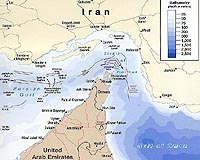 |
New Orleans, Louisiana (AFP) April 25, 2010 British oil giant BP used robotic underwater vehicles Sunday to try to cap a leaking well and prevent a growing oil slick in the Gulf of Mexico from developing into an environmental disaster. Satellite images showed the slick had spread by 50 percent in a day to cover an area of 600 square miles (1,550 square kilometers), although officials said some 97 percent of the pollution was just a thin veneer on the sea's surface. BP has dispatched skimming vessels to mop up the oil leaking from the debris of the Deepwater Horizon rig, which sank on Thursday, still blazing almost two days after a massive explosion that left 11 workers missing presumed dead. So far winds have been kind and the slick is not threatening the coast -- more than 40 miles away -- of Louisiana, where it could endanger ecologically fragile wetlands that are a paradise for rare waterfowl. "In the trajectory analysis we don't see any impact to any shoreline within the next three days," Charlie Henry, scientific support coordinator of the US government's National Oceanic and Atmospheric Administration (NOAA), told journalists. BP estimated that the leaks, some 5,000 feet (almost one mile) down on the seabed -- emanating from two holes in the riser that connects the wellhead to the sunken rig -- were releasing 1,000 barrels, 42,000 gallons, of oil a day. The coast guard, which conducted two overflights on Saturday and Sunday to assess the extent of the pollution, described it as a "very serious spill." The quickest way to stop the leaks is to activate the blow-out preventer, a piece of back-up equipment installed near the wellhead, which has failed to function properly since the rig went down. BP said it was trying to activate the giant 450-tonne, 50-foot high machine using remotely operated submersible vehicles. At the same time, it is preparing to drill relief wells that would permanently shut off the oil flow. "The drilling rig Development Driller III is moving into position to drill a second well to intercept the Macondo well and inject a specialized heavy fluid to securely prevent flow of oil or gas and allow work to be carried out to permanently seal the well," a statement said. Success with the blow-out preventer could stop the oil in a matter of days but the relief well operation could take weeks or "in a worst-case scenario -- months," BP officials said. Meanwhile, five aircraft and 32 spill response vessels -- skimmers, tugs, barges and recovery boats -- were hoping to resume efforts to mop up the slick after Saturday's weather delays. BP said chemical products had also been poured into the slick to help the dispersal process and more were in stock. "100,000 gallons of dispersant are ready to be deployed, which is a third of the world's dispersant commodity; BP is in contact with manufacturers to procure additional supply as necessary," it said. Environmental groups said they were preparing to protect the fragile ecosystem in Louisiana should the slick threaten the coastline. "This is a devastating spill," warned local environmental activist Anne Rolfes. Steve Benz, head of the independent Marine Spill Response Corporation, said that at BP's request he was mounting the largest response effort in his group's 20-year history. BP group chief executive Tony Hayward was adamant an environmental disaster would be avoided. "Given the current conditions and the massive size of our response, we are confident in our ability to tackle this spill offshore," he said. But officials have said the current spill has the potential to be the worst seen in the United States since the 1989 Exxon Valdez oil tanker spill, considered one of the worst man-made environmental disasters. That spill poured nearly 11 million gallons of crude into Alaska's Prince William Sound, devastating some 750 miles of its once pristine shores. There was still no news of the 11 missing Horizon crewmembers. The US coast guard, which helped evacuate another 115 to safety after Tuesday's spectacular blast, which shot balls of flame leaping into the night sky, aborted its massive air and sea search on Friday. Investigations are ongoing into the cause of the accident, which would be the worst in decades on a US offshore platform if the missing men are not found.
Share This Article With Planet Earth
Related Links Powering The World in the 21st Century at Energy-Daily.com
 Iran Guards boast of replacing sanctions-wary oil majors
Iran Guards boast of replacing sanctions-wary oil majorsTehran (AFP) April 24, 2010 Iran's powerful Revolutionary Guards boasted on Saturday that they can fill the gap in the country's energy sector left by Western oil firms pulling out in the face of new sanctions against Tehran. A top commander highlighted the unit's growing influence in the economy even as Guards ground, air and naval forces flexed their muscles in a drill in the key Strait of Hormuz oil route that began ... read more |
|
| The content herein, unless otherwise known to be public domain, are Copyright 1995-2010 - SpaceDaily. AFP and UPI Wire Stories are copyright Agence France-Presse and United Press International. ESA Portal Reports are copyright European Space Agency. All NASA sourced material is public domain. Additional copyrights may apply in whole or part to other bona fide parties. Advertising does not imply endorsement,agreement or approval of any opinions, statements or information provided by SpaceDaily on any Web page published or hosted by SpaceDaily. Privacy Statement |